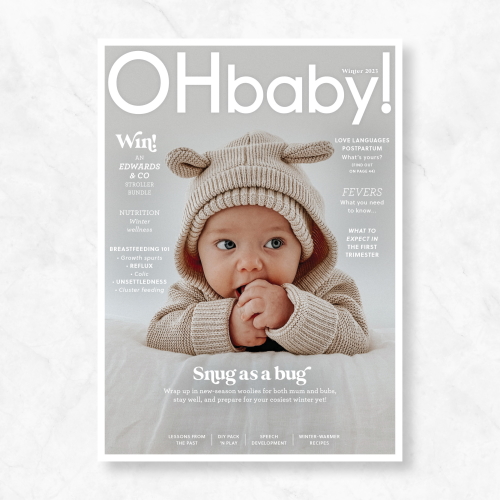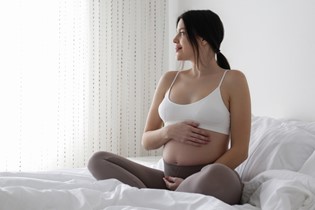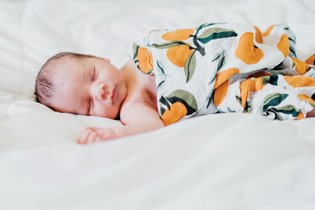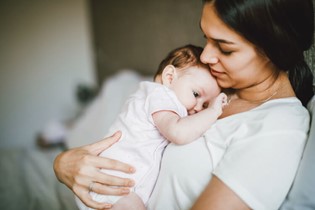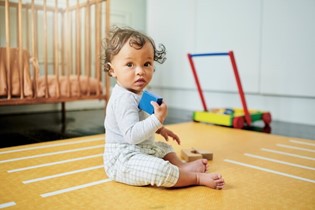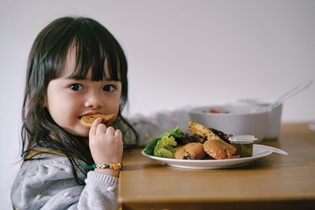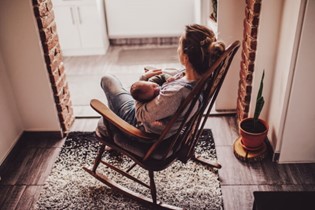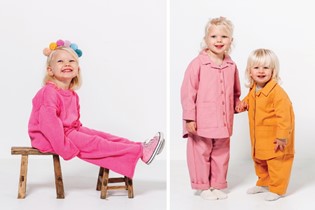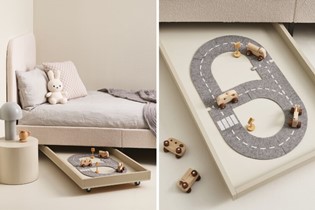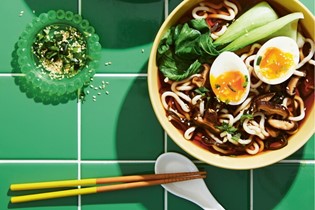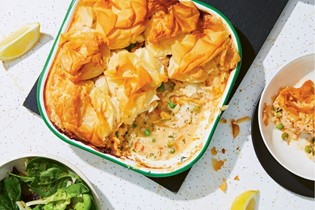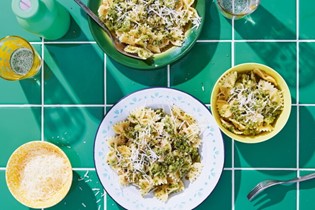Is sustainable parenting possible with a little one?

Sustainable parenting is tough. Eco-mama Fiona Ralph says ditch the guilt and focus on the bigger picture – and celebrate the little steps you are taking.
Just before my due date, I wrote a column about all the sustainable parenting decisions I had made in the lead up to my baby’s birth – and those I hoped to make once he was born. From sourcing clothes, furniture, toys and bedding secondhand, to researching the most ethical and natural skincare essentials and stocking up on reusable nappies and breast pads, I spent weeks ensuring my baby’s environmental footprint would be as small as possible.
Sixteen months later and things look a little different. With that crazy shift in priorities that comes with having a baby, being an eco-warrior just isn’t as manageable as it used to be. Time is limited, as is mental and physical energy. And my brain is half mush, thanks to the broken sleep schedule and constant exhaustion of being a new parent.
From the amount of things you need to buy at each stage, to the countless nappy and clothing changes, the food waste from the meals they throw on the floor, the broken toys, and the bibs that go mouldy when you forget to wash them in time – the obstacles are endless.
I was realistic in my pre-baby column, thankfully, and pointed out that my plans to use reusable nappies and make my own food may go out the window after the birth: “Ask me again when this is in print, and I’ll be waist-deep in nappies and sleepless nights, and might be singing the praises of disposable everything”. I got that right. The first months were a blur. There wasn’t much time to think about cutting back on waste. Mentally, things were not always easy. And with my husband doing a lot while I was camped out on the couch under a sleeping baby, I wasn’t as across the sustainable shopping – and disposing – decisions.
There was no longer time for Trade Me pickups or hours of research into ethical buys. Shopping had to be easy, and usually a trip to the nearest store or supermarket was the quickest option. Nappies were a constant source of guilt. The plan to switch to reusables at six weeks extended to three months, then six months. For a while, inspired by Kate Meads of Waste Free with Kate & Co, I used one a day. Eventually though, even that fell by the wayside.
If this sounds like you too – with all the best intentions but struggling to follow through, don’t feel bad. You’re likely running on little sleep and limited energy. You’ve also got to consider your mental and physical health.

Many of us are doing double duty – more New Zealand mums are working now than ever before. We also live in a time where the responsibility of looking after the planet weighs heavily on our shoulders. In the excellent Vox article “The complicated gender politics of going zero waste”, Alden Wicker writes that sustainability has become women’s work. Just another thing we have to manage in the household, and another way of proving to society we are enough. When in fact, those dreaded disposables, and many of life’s other conveniences, were introduced to make our lives easier. “Keep in mind that the plastic packaging required for frozen food and sliced bread is arguably one of the things that allowed women to enter the workforce in the first place,” Wicker writes. She quotes Susan Dobscha, a professor of marketing at Bentley University, who says that the reason people started buying premade things is because they were working longer hours.
Wicker also talks about our need for perfection: “Women are so afraid of being called out for hypocrisy and failure, we feel like we can’t call ourselves an environmentalist unless we’ve brought our daily lives 100 percent in line with our values.”
Which is a pity, because there is already enough mum shame – not to mention eco shame – going around. So instead of celebrating the fact that most of my child’s clothes, toys and other essentials are secondhand, I’m feeling guilty because I haven’t mastered reusable nappies or sometimes feed him packaged food.
The paradox is, as important as individual actions are, one reusable nappy is not going to save the world. It’s dangerous (and clever marketing by corporations) to place the onus solely on individuals, when in fact a much bigger systemic shift is needed. You could argue that voting for sustainable and ethical political leaders is the biggest step you could take for the planet, to ensure we have a society where climate change is prioritised, we have better access to parental mental healthcare, repair cafes and community sharing programs are funded, and there are more commercial composting facilities – and curbside pickups for those compostables.
We also need to advocate for businesses to change, so that parents – including men – get more paid leave and more flexible working policies, compostable materials are used for nappies, wipes and baby food packaging, plastic materials are not used as often in clothing and toys, and companies take back or repair items when they reach the end of their life cycle.
This isn’t to say you shouldn’t make an effort, and that you shouldn’t switch to reusables if you can. And if you are nailing sustainable parenting, I salute you. But if you’re struggling, try to give yourself a little leniency. Even someone like me, whose passion for sustainability was strong before becoming a parent, is struggling.
However, as I near the eighteen month mark, it’s slowly getting easier. We’re bringing back more sustainable practises as we have more time and energy. And I can see a light at the end of the nappy tunnel, as I stare down the barrel of toilet training. Now comes the fun part – no, not the toilet training – teaching our son to look after the planet so he can carry the torch for us one day.
FIONA'S TOP TIPS
Sustainability doesn’t have to be all or nothing. Even doing one of these things can be worthwhile...
Nappies: Try using just one reusable nappy a day. Or try disposable liners if that helps make reusable nappies more achievable. Don’t forget to put the poo in the toilet even if you use disposables (when it’s solid enough!) so this doesn’t go to landfill. Reusable swim nappies can also be a manageable swap.
Materials: Choose natural fibers when you can. (Ignore the fact that your baby prefers to chew on a plastic packet rather than their all-natural teething toy.)
Food: If possible, keep the packaged food for when you’re out and about or travelling, or for emergencies (like when you’re sick or there is no food in the house!).
Baby gear: Buy or borrow secondhand items, and pass things on when you’re done. Facebook groups, Trade Me, op shops, friends and antenatal groups are great. You can also hire items like car seats, clothes (check out ohtheygrow.co.nz) and even nappies.
Toys and books: Join a library and toy library – you’ll save lots of money on toys and books, and figure out what is actually worth buying rather than investing in things that may be forgotten after a day.
Wipes: Use flannels for cleaning up food mess at home and keep the wipes for when you’re on the go.
Nappy changing items: Cut down on extra items such as disposable nappy bags and change mat covers. Use a reusable change mat cover and reusable wet bag to put nappies or dirty clothes in when you’re out, or put nappies straight in the bin.
Essentials: Buy less. Wait until you know if you will really need something rather than buying the entire list of things people say you need when you have a baby. Borrow things like carriers first to see if you like them. Make do with something that may be passed on but not perfect.
Packaging: Reduce your use of plastic bottles – you may find you don’t actually need baby oil, baby wash and lotion. There are solid baby soaps and moisturisers you can buy too. You also don’t need to bathe baby every day – in fact it’s better for their skin not to.
Education: Teach your kids about the planet and how to look after it – read them books about the environment, get them to help you pick up rubbish on the beach and have them join in the recycling and reusing.
Reusable Nappy Frequently Asked Questions
HOW MANY DO I NEED?
This depends on how often you use them, and how often you plan to wash them. If you're wanting to go full reusables and plan on washing every day, you'll generally need enough to last two days so you can have one lot in the wash and one in use. On average, your baby will go through around six nappies a day, but if you're planning on using them on your newborn, you should plan to use between eight to 10 a day. If you're using pocket nappies or all-in-ones, you'll need between 12 to 18 as you change the whole nappy at each change. If you're using prefolds or fitted nappies and covers, you'll need 12 to 18 prefolds or fitted nappies and three or four covers as you only need to change the cover when it's soiled.
HOW MUCH WILL IT COST ME?
The old saying "you get what you pay for" is very true in this case, and it is definitely worth looking at some of the more expensive premium brands. As well as the cost, you also have to consider the ongoing costs of washing them - electricity, water, washing powder and so on. Cloth nappies will save you even more if you use them for more than one child, and obviously each use of a reusable nappy will save you the cost of a disposable. There are lots of good quality secondhand options available online also, worth checking them out.
DO I HAVE TO SOAK THEM?
Short answer – no. Unlike traditional flat cloth nappies, modern cloth nappies don't require scrubbing or soaking. Most users "dry pail" - when a nappy is wet or dirty, they flush any solids, then put the nappy into an empty, open basket until they're ready to wash them. When you're out and about, nappies can be stored in a wet bag (made from water resistant fabric), then rinsed and dry-pailed when you get home.
HOW DO I WASH THEM?
Always follow the wash care instructions on the care label because the manufacturer will have tested different washing scenarios. If they have hook and loop laundry tabs, make sure you fold these over or do them up, as they could damage your nappies in the wash otherwise. Don't leave them for more than two days before washing, especially if you want to reduce the chance of your nappies staying stained. Don't soak your nappies in harsh stain removers, or use bleach – they will shorten the lifespan of your nappies and in most cases void your guarantee. The best way to dry your nappy shells/covers is in the shade, as the sun or heat can damage the fabric. Inserts can be hung in direct sunlight or popped in the drier if you prefer. See kekoa.co.nz for more information on washing.
DO I NEED LINERS?
This is purely personal choice. Some people prefer to use liners to make the nappies easier to clean, others simply flush the soiling straight off the nappy. If you decide to use liners, pay attention to the ones you choose – it is not advisable to flush them so you need to have a way of disposing of them (even if they say flushable.)
WHAT ABOUT WHEN WE GO OUT?
Keep a small wet bag in your nappy bag and simply pop the wet nappy into it to take home. If it's a dirty nappy, flush the solids first, as this will stop your wet bag smelling. If you find your wet bag does start to smell a little with time, simply turn it inside out and pop it through the wash with your nappies.
WHAT ABOUT NIGHT TIME?
Ah, the elusive night nappy! It's really a case of trial-and-error, as what works for one baby, might not work for another. Generally speaking, prefolds aren't suitable for use as night nappies, but they make very useful inserts when folded into a pad shape and put inside a pocket nappy. Some people swear by fitted nappies and covers for nighttime use; in this case, you need to choose a fitted with plenty of absorption, maybe one with hemp or bamboo sewn in, or use a booster. You also need to choose a heavy-duty cover; wool covers work particularly well overnight.
If you want to use pocket nappies, it's a matter of finding one that fits snugly enough around the thighs and waist so as not to leak, but also has enough room for plenty of stuffing. Bamboo and hemp make good night time inserts, as do traditional flat nappies folded into a pad shape. Experiment until you find a combination that works for you. For very heavy wetters, a woolen soaker over the top of a night nappy is almost guaranteed to keep the sheets dry.
Fiona is a freelance writer with a passion for sustainability, living in Auckland with her husband CP, son Jude, and cat Rocky.

AS FEATURED IN ISSUE 62 OF OHbaby! MAGAZINE. CHECK OUT OTHER ARTICLES IN THIS ISSUE BELOW
